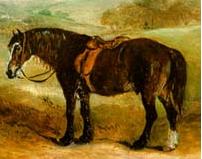Welsh Pony and Cob
N/A
Sat, 19th July, 2025 - 2:57 am GMT
Sponsor Ads:

Alternative Name
N/ABasic Info
The general description of the Welsh Mountain Pony can be applied to the Welsh Pony, with greater emphasis being placed on riding pony qualities while still retaining the true Welsh quality with substance. For generations these ponies were the hill farmers’ main means of transport, herding sheep and wild ponies over rough and mountainous country. They had to be hardy, balanced and fast to survive, which ensured that only the best were bred from. These qualities, combined with a natural jumping ability, and the temperament of their Welsh Mountain Pony forebears make the Welsh Pony second to none in whatever field his young rider may choose. Today the hold their own among top class riding ponies both in performance competition and in the show ring.
Health
Originally in the first British Stud Books (1902), the Welsh registry listed the Welsh Pony of Cob Type as Section B (12:2hh to 13:2hh), and the Welsh Cob as Section C (13:2hh to 14:2hh) and Section D (14:2hh to 15:2hh). In 1907, the upper height limit for the Section D was removed. In 1931, all Sections of Cobs were combined and labeled "C." This encompassed all sizes of Cobs. In 1949, the Cob Sections were changed to the current standards - Section C as 13:2hh and under, the Section D being over 13:2hh without an upper limitHabitat
N/ABehavior
The Welsh Pony and Cob Society was founded in Wales in 1901 and their first studbook was published in 1902.Origin
Hills and valleys of WalesHistory
The Welsh Pony and Cob Society was founded in Wales in 1901 and their first studbook was published in 1902. The original classification for Welsh ponies was Section A, the Welsh Mountain Pony. With a great need for children’s riding ponies Section B, the Welsh Pony, was added in 1931. With Section A ponies as its foundation, the breed standard for Section B is the same as for Section A but ‘more particularly the Section B pony shall be described as a riding pony, with quality, riding action, adequate bone and substance, hardiness and constitution and with pony character.’Common Foods
grassSponsor Ads:
"A little science estranges a man from God. A lot of science brings him back." -- Francis Bacon
Welsh Pony and Cob
Coded by: BGID® | ALL RIGHTS RESERVED Copyright © 2000-2025
Disclaimer | Privacy | Report Errors / Contact | Credits


 President of the United States of America - Real Estate mogul, Pageant owner and now one of the most controversial men in political history.
President of the United States of America - Real Estate mogul, Pageant owner and now one of the most controversial men in political history.  Global warming has been in and out as the "latest" hot topic for many years. It is, according to modern scientists, the result of man-made industrial pollutants, clearing forested areas, agriculture, etc. But now they are thinking it started way before the Industrial Revolution...
Global warming has been in and out as the "latest" hot topic for many years. It is, according to modern scientists, the result of man-made industrial pollutants, clearing forested areas, agriculture, etc. But now they are thinking it started way before the Industrial Revolution...  Politician, US Vice President and President of the USA - Joseph Robinette Biden Jr.
Politician, US Vice President and President of the USA - Joseph Robinette Biden Jr.  versus
versus  Russia: 'The Evil Empire'? Are they all that bad or is it just the USA trying to portray Russia as bad because they are a world power with land bigger and a society very different from the USA ideal?
Russia: 'The Evil Empire'? Are they all that bad or is it just the USA trying to portray Russia as bad because they are a world power with land bigger and a society very different from the USA ideal? 
 Corona virus
Corona virus 
 Users with wide screen monitors can benefit from more content on every page.
Users with wide screen monitors can benefit from more content on every page.